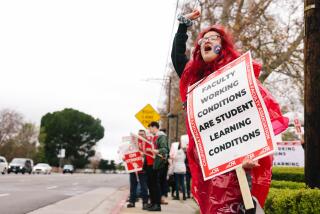Protect good teachers, fire bad ones
State laws that make it nearly impossible to fire even the worst teachers make for poor educational policy. The same is true of laws that require teacher layoffs to be decided on the basis of seniority, and that give principals only a year and a half to decide whether a new teacher deserves the extraordinary protections of tenure. It seems pretty obvious: Incompetent or uncaring teachers shouldn’t be allowed to keep their jobs.
On Monday, a trial will begin in a lawsuit that claims California’s teacher protection laws unconstitutionally deprive students of equal access to a quality education. The plaintiffs’ legal team includes Theodore J. Boutrous Jr. and Theodore B. Olson, whose legal attack on Proposition 8 opened the way to same-sex marriage in California.
Much as we agree that tenure and seniority laws can impede students’ ability to learn, we are skeptical that they rise to the level of a violation of the state Constitution. Not every bad law is unconstitutional. The tendency of school districts to place a higher proportion of ineffective teachers in low-income schools is of course unacceptable, but that’s not the fault of tenure laws.
If nothing else, though, perhaps the lawsuit will convince legislators that their failure to loosen teacher protection laws cannot continue indefinitely. If they don’t fix the problem, others will do so through court cases or ballot measures, and the results might be less balanced than a good bill.
At the heart of the debate are laws that create an arcane, time-consuming and costly process for firing even the worst instructors — those accused of molestation, or the ones who play nonstop movies on a classroom TV while they sit in the back of the room reading a newspaper, or those who harshly belittle even the youngest students, making them feel stupid from their earliest days of learning. Of course the vast majority of teachers don’t do these things, but the damage caused by those who do is outsized because once students fall behind or become discouraged, it’s hard to get them back on track. Boutrous and others have estimated that 5% to 10% of teachers don’t belong in their jobs, and that sounds realistic.
The fallout is especially damaging to students from poor or uneducated families. Their parents may not have the money or the academic skills to provide tutoring, and many feel too intimidated to complain. If they do, they’re often told nothing can be done because it’s too hard to fire a teacher.
A big part of the problem in California is the appeals process, which is handled by a panel composed of an administrative law judge and two teachers. The rules and regulations for picking those teachers are complicated and difficult to meet, and the resulting board is almost always weighted in favor of the aggrieved teacher. Meanwhile, parents and students have no representative on the panel. The process drags on for months, sometimes years.
Some school reformers would prefer to eliminate any meaningful appeals process and leave the final say to administrators and school boards. We disagree. Teachers need protection from capricious or vengeful firings that might be more about their willingness to speak up or maintain high standards than about their prowess in the classroom. Nor should they be fired simply because they earn higher salaries. California should look to New Jersey’s example and consider binding arbitration as a quicker and fairer way of resolving disputes. Another option would be to reduce the appeals panel to a judge, without the addition of teachers.
The state’s influential and well-funded teachers unions, especially the California Teachers Assn., have managed so far to fend off reforms. But this lawsuit, bankrolled by a Silicon Valley entrepreneur, is the first formal signal that powerful interests are lined up against them. Wealthy businesspeople have been major backers of the school reform effort, and though we don’t always agree with their aims or tactics, they are balancing the lopsided influence that the unions have wielded for too long.
This lawsuit might not prevail — the argument appears to be a stretch, if a bold one — but already there is talk of two or three possible ballot measures on the same issues. The CTA and the Legislature would be smart to figure out a reasonable way to streamline the dismissal process. If they continue to obstruct and delay, someone else will do the figuring for them.
More to Read
A cure for the common opinion
Get thought-provoking perspectives with our weekly newsletter.
You may occasionally receive promotional content from the Los Angeles Times.






